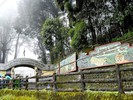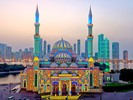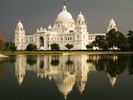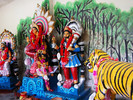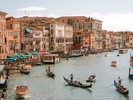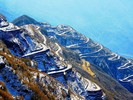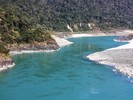Ranomafana National Park
It is Located in the southeastern region of Madagascar near the village of Ranomafana, the Ranomafana National Park is one of the nation's most popular parks. The eastern section of the park is the most scenic, with numerous streams splashing through densely forested hills.
Andasibe-Mantadia
Encompassing around 100 miles of land in eastern Madagascar, Andasibe-Mantadia National Park is home to eleven lemur species, including the country's largest lemur, the Indri. Located near Madagascar's capital city of Antananarivo, Andasibe-Mantadia is one of the easiest parks to visit. The park is split into two areas, the Mantadia National Park and the Analamazoatra Reserve. Local guides conduct 1- to 6-hour tours of either area
Ifaty
Ifaty is the name given to two dusty fishing villages on the coast of southwest Madagascar. Offshore, a 60-mile long coral reef is a natural barrier to rough sea waves, creating coastal waters that are ideal for diving, snorkeling and fishing. The desert inland area is known for its spiny forest, where the strange-shaped baobab trees have thrived for centuries.
Tsingy de Bemaraha
The Tsingy de Bemaraha Reserve lies in the southern region of Madagascar's largest natural reserve, Tsingy de Bemaraha Strict Nature Reserve. The word "tsingy" refers to the pinnacles that dot the park's limestone plateau. Located near the country's west coast, the park features a broad expanse of mangrove forest. The park is home to seven lemur species, including the Deckenssifaka, a genus of lemur notable for its creamy white fur and black face.
Nosy Be
The small island of Nosy Be is one of Madagascar's premier tourist spots attracting thousands of tourists from across the globe year round. Although Nosy Be's beaches don't look as picture perfect as some other tropical beaches, they do win points for tranquility, clear turquoise water and excellent seafood restaurants serving seafood diner on the sand.
Ile Sainte Marie
The Ile Sainte Marie lies off the east coast of Madagascar. The island's array of protected bays and inlets drew pirates to Ile Sainte Marie during the 17th and 18th centuries, and the wrecks of several pirate ships can still be viewed from the shallow waters of the Baie des Forbans. Today the island is one of the top tourist attractions in Madagascar. The still, clear waters of the island's bays make ideal spots for snorkeling. Migrating humpback whales visit the island waters during summer and early fall.
